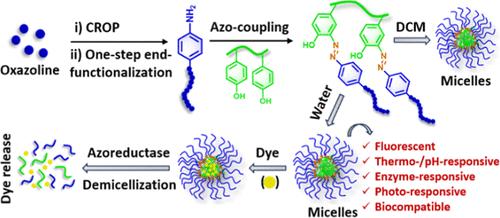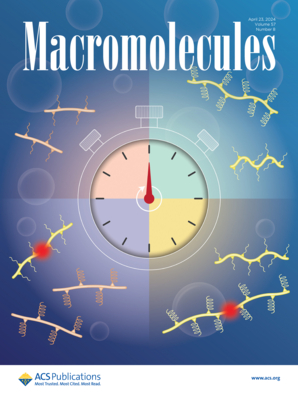Versatile Azo-Coupling Route to Amphiphilic Poly(2-Oxazoline) Graft Copolymers for Multi-Responsive Micelles and Enzymatic Demicellization
IF 5.1
1区 化学
Q1 POLYMER SCIENCE
引用次数: 0
Abstract
The development of stimuli-responsive azocopolymer amphiphiles, especially those responsive to pH, light, thermal, and enzyme stimuli, as well as their micellization/demicellization, remains a challenging endeavor for their application in drug delivery. In this work, first, a tailor-made p-aminobenzoic acid end-capped poly(2-ethyl-2-oxazoline) (PABA–PEtOx) is synthesized by a one-pot technique involving cationic ring-opening polymerization (CROP) followed by chain-termination. It is then allowed for diazotization to PEtOx–PABA–N2+Cl– for coupling with electron-rich phenolic polymers, such as poly(l-tyrosine) or poly(4-vinylphenol) to produce azo-bridged water-soluble PTyr–N2–PEtOx or PVPh–N2–PEtOx graft copolymers. The grafted PEtOx segments introduce tunable lower critical solution temperature (LCST)-type phase behavior into copolymers in response to the pH and polymer concentration. The absorbance of trans- and cis-azobenzene peaks in copolymers varies with pH and the irradiation time of light. Amphiphilicity drives the self-assembly of copolymers into spherical micelles, with hydrophobic azo-bridged PTyr/PVPh segments in the core exhibiting unusual emission in water as well as in DCM. Intriguingly, the temperature above which a significant jump in emission intensity is observed, due to copolymer’s micellar agglomeration, can be correlated with the cloud point. The micellar size increases with increasing pH and shape deforms upon light irradiation. The acidic treatment of PVPh-N2–PEtOx produces poly(4-vinylphenol)-N2–poly(ethylene imine) (91% hydrolyzed) copolymer with no LCST in water. The copolymer micelles with low cytotoxicity disintegrate with azoreductase treatment, which triggers the release of Nile red (NR) dye from the NR-loaded micelles. The synthetic approach is simple, yet versatile and can be extended for preparing thermoresponsive azo-bridged bioconjugate by coupling PEtOx–PABA-N2+Cl– with BSA protein.

求助全文
约1分钟内获得全文
求助全文
来源期刊

Macromolecules
工程技术-高分子科学
CiteScore
9.30
自引率
16.40%
发文量
942
审稿时长
2 months
期刊介绍:
Macromolecules publishes original, fundamental, and impactful research on all aspects of polymer science. Topics of interest include synthesis (e.g., controlled polymerizations, polymerization catalysis, post polymerization modification, new monomer structures and polymer architectures, and polymerization mechanisms/kinetics analysis); phase behavior, thermodynamics, dynamic, and ordering/disordering phenomena (e.g., self-assembly, gelation, crystallization, solution/melt/solid-state characteristics); structure and properties (e.g., mechanical and rheological properties, surface/interfacial characteristics, electronic and transport properties); new state of the art characterization (e.g., spectroscopy, scattering, microscopy, rheology), simulation (e.g., Monte Carlo, molecular dynamics, multi-scale/coarse-grained modeling), and theoretical methods. Renewable/sustainable polymers, polymer networks, responsive polymers, electro-, magneto- and opto-active macromolecules, inorganic polymers, charge-transporting polymers (ion-containing, semiconducting, and conducting), nanostructured polymers, and polymer composites are also of interest. Typical papers published in Macromolecules showcase important and innovative concepts, experimental methods/observations, and theoretical/computational approaches that demonstrate a fundamental advance in the understanding of polymers.
 求助内容:
求助内容: 应助结果提醒方式:
应助结果提醒方式:


